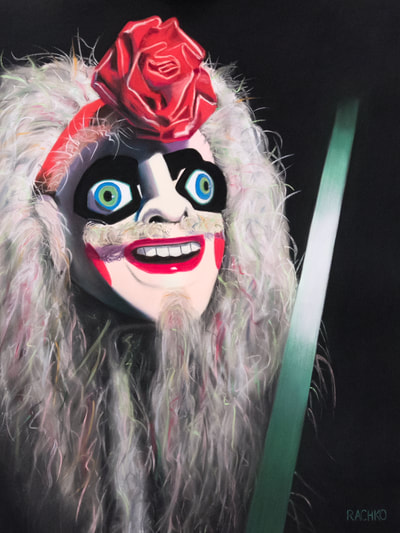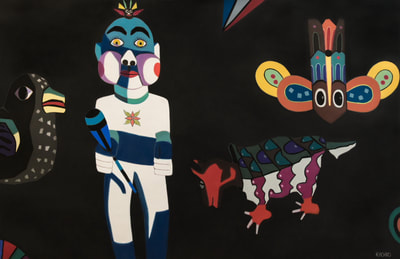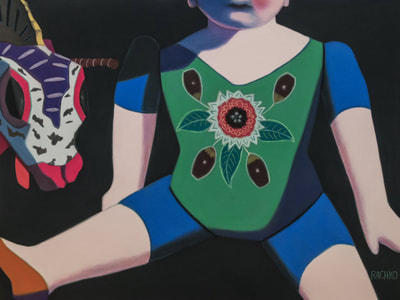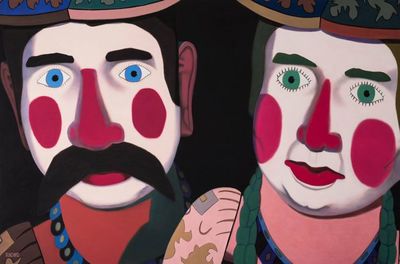June 2018
INVITATIONAL EXHIBITION
BARBARA RACHKO
INVITATIONAL EXHIBITION
BARBARA RACHKO
Artistic Statement
THE BLACK PAINTINGS
The assimilation of styles and motifs from African cultural artifacts into the work of avant-gard
artists was a means of challenging conventional western aesthetic values and hierarchies that reflected what those artists perceived as a vacuous and moribund society. In looking to these sources to invigorate their own creative visions, what these artists actually discovered were new ways of seeing and making art. Wendy Grossman in Man Ray, African Art, and the Modernist Lens
I am drawn to Mexican and Guatemalan cultural objects—masks, carved wooden animals, papier mâché figures, and toys—for reasons similar to those of Man Ray and the modernists, who in their case were drawn to African art. On trips to southern Mexico and Guatemala I frequent local mask shops, markets, and bazaars searching for the figures that will later populate my pastel paintings and photographs. How, why, when, and where these objects come into my life is an important part of the process. I take very old objects with a unique Mexican or Guatemalan past—most have been used in religious festivals—and give them a second life, so to speak, in New York in the present. When I return home I read prodigiously and find out as much about them as I can.
The BLACK PAINTINGS series of pastel-on-sandpaper paintings grew directly from the earlier DOMESTIC THREATS. Both series use cultural objects as surrogates for human beings acting in mysterious, highly-charged narratives. In the BLACK PAINTINGS the figures (actors) now take central stage. All background details, furniture, rugs, etc. are eliminated and are replaced by intense dark black pastel. Each painting takes months to complete as I slowly build up as many as 30 layers of soft pastel.
The idea for the BLACK PAINTINGS began when I attended a jazz history course and learned how Miles Davis developed cool jazz from bebop. In bebop the notes were played hard and fast as musicians showcased their technical virtuosity. Cool jazz was a much more relaxed style with fewer notes, i.e., the music was pared down to its essentials. Similarly my current series evolved from dense, complex visual compositions into paintings that depict only the essential elements—the actors.
THE BLACK PAINTINGS
The assimilation of styles and motifs from African cultural artifacts into the work of avant-gard
artists was a means of challenging conventional western aesthetic values and hierarchies that reflected what those artists perceived as a vacuous and moribund society. In looking to these sources to invigorate their own creative visions, what these artists actually discovered were new ways of seeing and making art. Wendy Grossman in Man Ray, African Art, and the Modernist Lens
I am drawn to Mexican and Guatemalan cultural objects—masks, carved wooden animals, papier mâché figures, and toys—for reasons similar to those of Man Ray and the modernists, who in their case were drawn to African art. On trips to southern Mexico and Guatemala I frequent local mask shops, markets, and bazaars searching for the figures that will later populate my pastel paintings and photographs. How, why, when, and where these objects come into my life is an important part of the process. I take very old objects with a unique Mexican or Guatemalan past—most have been used in religious festivals—and give them a second life, so to speak, in New York in the present. When I return home I read prodigiously and find out as much about them as I can.
The BLACK PAINTINGS series of pastel-on-sandpaper paintings grew directly from the earlier DOMESTIC THREATS. Both series use cultural objects as surrogates for human beings acting in mysterious, highly-charged narratives. In the BLACK PAINTINGS the figures (actors) now take central stage. All background details, furniture, rugs, etc. are eliminated and are replaced by intense dark black pastel. Each painting takes months to complete as I slowly build up as many as 30 layers of soft pastel.
The idea for the BLACK PAINTINGS began when I attended a jazz history course and learned how Miles Davis developed cool jazz from bebop. In bebop the notes were played hard and fast as musicians showcased their technical virtuosity. Cool jazz was a much more relaxed style with fewer notes, i.e., the music was pared down to its essentials. Similarly my current series evolved from dense, complex visual compositions into paintings that depict only the essential elements—the actors.
For inquiries contact the artist directly:
212-643-6293 703-998-7496
www.barbararachkoscoloreddust.com
www.facebook.com/barbararachko
www.barbararachko.com
http://museumofnonvisibleart.com/interviews/barbara-rachko/
Barbara’s first eBook, From Pilot to Painter, is available on Amazon
https://www.amazon.com/dp/B00HNVR200
http://bit.ly/BarbaraRachkoFromPilotToPainter










